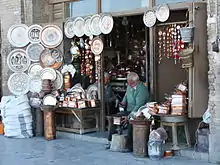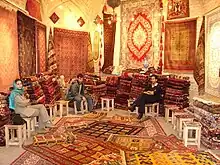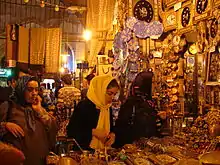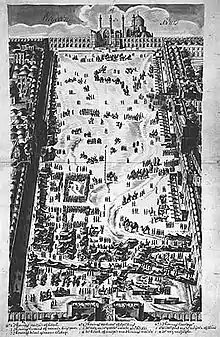| Qeysarie Bazaar | |
|---|---|
بازار قیصریه | |
.jpg.webp) | |
 Location within Iran | |
| Alternative names | Soltani bazaar |
| General information | |
| Status | Cultural |
| Type | bazaar |
| Architectural style | Isfahani |
| Location | Isfahan, Iran |
| Coordinates | 32°39′47″N 51°40′31″E / 32.6631°N 51.6753°E |
| Completed | 1620 |




The Grand Bazaar (Persian: بازار بزرگ, transliterated: Bāzār-e Bozorg) is a market located in Isfahan, Iran, also known as the Qeysarriyeh Bazaar (بازار قيصريه), Qeysarie bazaar or Soltani bazaar.
The bazaar was one of the greatest and most luxurious trading centers in the Safavid era. It was built in 1620 on the northern side of Naqsh-e Jahan Square. It connects the Naqsh-e Jahan Square to the Kohneh Square and Seljukid part of Isfahan.[1][2]
History
It was originally constructed during the 11th century on the southwest wing of the Jameh Mosque and Kohneh Square, but various arcades and rooms were later added.
The bazaar, one of the oldest and largest in the Middle East, dates to Seljukid and Safavid era and is the longest roofed market in the world. [3] The site has been destroyed several times and the contemporary bazaar dates to the 17th century. The bazaar is a vaulted two-kilometre street linking the old city with the new.[4]
In the Middle-East, bazaars were typically situated in close proximity to the mosque and the Isfahan Bazaar is no exception. The Bazaar of Isfahan is located in downtown old Isfahan, Iran, in the northern section of the Naqsh-e Jahan Square. The main entrance called Qeisarieh stretches through to Jameh Mosque, the oldest mosque in Isfahan, and one of the oldest in Iran.[5]

See also
References
- ↑ "سردر بازار قیصریه". تیشینه (in Persian). Retrieved 2019-03-10.
- ↑ "درگاه الکترونیکی شهرداری اصفهان". www.isfahan.ir. Retrieved 2019-03-10.
- ↑ Assari,A., Mahesh, T.M., Emtehani, M.E. and Assari, E., "Comparative Sustainability of Bazaar in Iranian Traditional Cities: Case Studies of Isfahan and Tabriz," International Journal on “Technical and Physical Problems of Engineering”, Vol. 3, no. 9, 2011, pp 18-24; Iran Chamber of Commerce, <Online: http://www.iranchamber.com/architecture/articles/bazaar_of_isfahan1.php#sthash.BB3fHqgx.dpuf>
- ↑ "Bazaar at Isfahan". Archnet.org. Archived from the original on 2006-02-26. Retrieved 2007-07-19.
- ↑ Assari, Ali; T.M. Mahesh (December 2011). "Comparative Sustainability of Bazaar in Iranian Traditional Cities: Case Studies in Isfahan and Tabriz" (PDF). International Journal on Technical and Physical Problems of Engineering (IJTPE). 3 (9): 18–24. Retrieved 6 January 2013.
Bibliography
External links
![]() Media related to Isfahan Grand Bazaar at Wikimedia Commons
Media related to Isfahan Grand Bazaar at Wikimedia Commons

